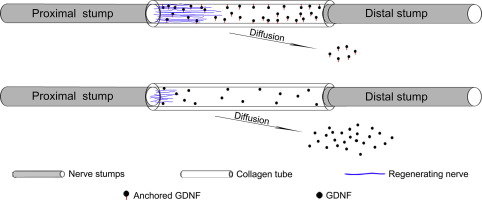Acta Biomaterialia ( IF 9.7 ) Pub Date : 2018-01-10 , DOI: 10.1016/j.actbio.2018.01.001 Fukai Ma , Feng Xu , Ronggang Li , Yongtao Zheng , Fan Wang , Naili wei , Junjie zhong , Qisheng Tang , Tongming Zhu , Zhifu Wang , Jianhong Zhu

|
Facial nerve injury caused by traffic accidents or operations may reduce the quality of life in patients, and recovery following the injury presents unique clinical challenges. Glial cell-derived neurotrophic factor (GDNF) is important in nerve regeneration; however, soluble GDNF rapidly diffuses into body fluids, making it difficult to achieve therapeutic efficacy. In this work, we developed a rat tail derived collagen conduit to connect nerve defects in a simple and safe manner. GDNF was immobilized in the collagen conduits via chemical conjugation to enable controlled release of GDNF. The GDNF delivery system prevented rapid diffusion from the site without impacting bioactivity of GDNF; degradation of the collagen conduit was inhibited owing to the chemical conjugation. The artificial nerve conduit was then used to examine facial nerve regeneration across a facial nerve defect. Following transplantation, the artificial nerve conduits degraded gradually without causing dislocations and serious inflammation, with good integration into the host tissue. Functional and histological tests indicated that the artificial nerve conduits were able to guide the axons to grow through the defect, reaching the distal stumps. The degree of nerve regeneration in the group that was treated with the artificial nerve conduit approached that of the autograft group, and exceeded that of the other conduit grafted groups.
Statement of Significance
In this study, we developed artificial nerve conduits consisting of GDNF immobilized on collagen, with the aim of providing an environment for nerve regeneration. Our results show that the artificial nerve conduits guided the regeneration of axons to the distal nerve segment. GDNF was immobilized stably in the artificial nerve conduits, and therefore retained a sufficient concentration at the target site to effectively promote the regeneration process. The artificial nerve conduits exhibited good biocompatibility and facilitated nerve regeneration and functional recovery with an efficacy that was close to that of an autograft, and better than that of the other grafted groups. Our approach provides an effective delivery system that overcomes the rapid diffusion of GDNF in body fluids, promoting peripheral nerve regeneration. The artificial nerve conduit therefore qualifies as a putative candidate material for the fabrication of peripheral nerve reconstruction devices.
中文翻译:

胶质细胞来源的神经营养因子在面神经再生中的胶原导管中的持续传递
交通事故或手术造成的面神经损伤可能会降低患者的生活质量,受伤后的康复提出了独特的临床挑战。胶质细胞源性神经营养因子(GDNF)在神经再生中很重要。但是,可溶性GDNF迅速扩散到体液中,难以达到治疗效果。在这项工作中,我们开发了一种大鼠尾巴衍生的胶原蛋白导管,以简单安全的方式连接神经缺损。GDNF通过化学偶联固定在胶原蛋白导管中,以实现GDNF的控制释放。GDNF输送系统可防止从部位快速扩散,而不会影响GDNF的生物活性。由于化学结合,抑制了胶原蛋白导管的降解。然后使用人工神经导管检查整个面神经缺损处的面神经再生情况。移植后,人工神经导管逐渐降解而不会引起脱位和严重的炎症,并与宿主组织良好融合。功能和组织学测试表明,人工神经导管能够引导轴突穿过缺损生长,到达远端残端。人工神经导管治疗组的神经再生程度接近自体移植组,超过了其他人工血管移植组。功能和组织学测试表明,人工神经导管能够引导轴突穿过缺损生长,到达远端残端。人工神经导管治疗组的神经再生程度接近自体移植组,超过了其他人工血管移植组。功能和组织学测试表明,人工神经导管能够引导轴突穿过缺损生长,到达远端残端。用人工神经导管治疗组的神经再生程度接近自体移植组,超过其他导管移植组。
重要声明
在这项研究中,我们开发了由固定在胶原蛋白上的GDNF组成的人工神经导管,旨在为神经再生提供环境。我们的结果表明,人工神经导管将轴突的再生引导至远端神经节段。GDNF稳定地固定在人工神经导管中,因此在目标部位保留了足够的浓度以有效地促进再生过程。人工神经导管表现出良好的生物相容性,并促进神经再生和功能恢复,其功效接近自体移植,且优于其他移植组。我们的方法提供了一种有效的输送系统,该系统克服了GDNF在体液中的快速扩散,促进了周围神经的再生。


























 京公网安备 11010802027423号
京公网安备 11010802027423号